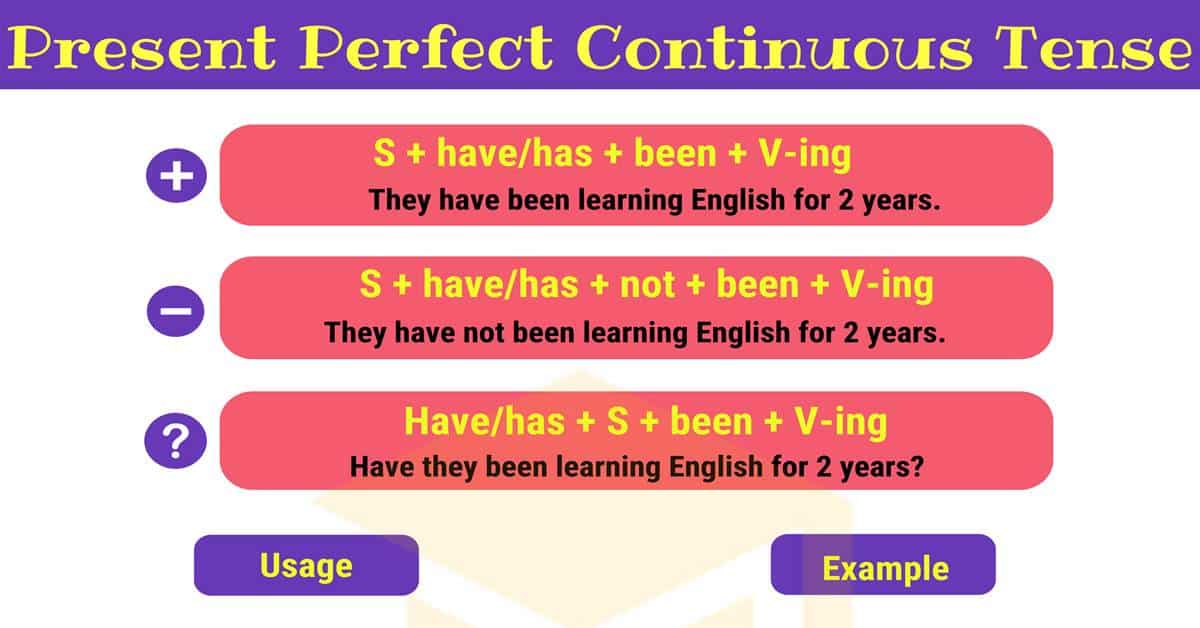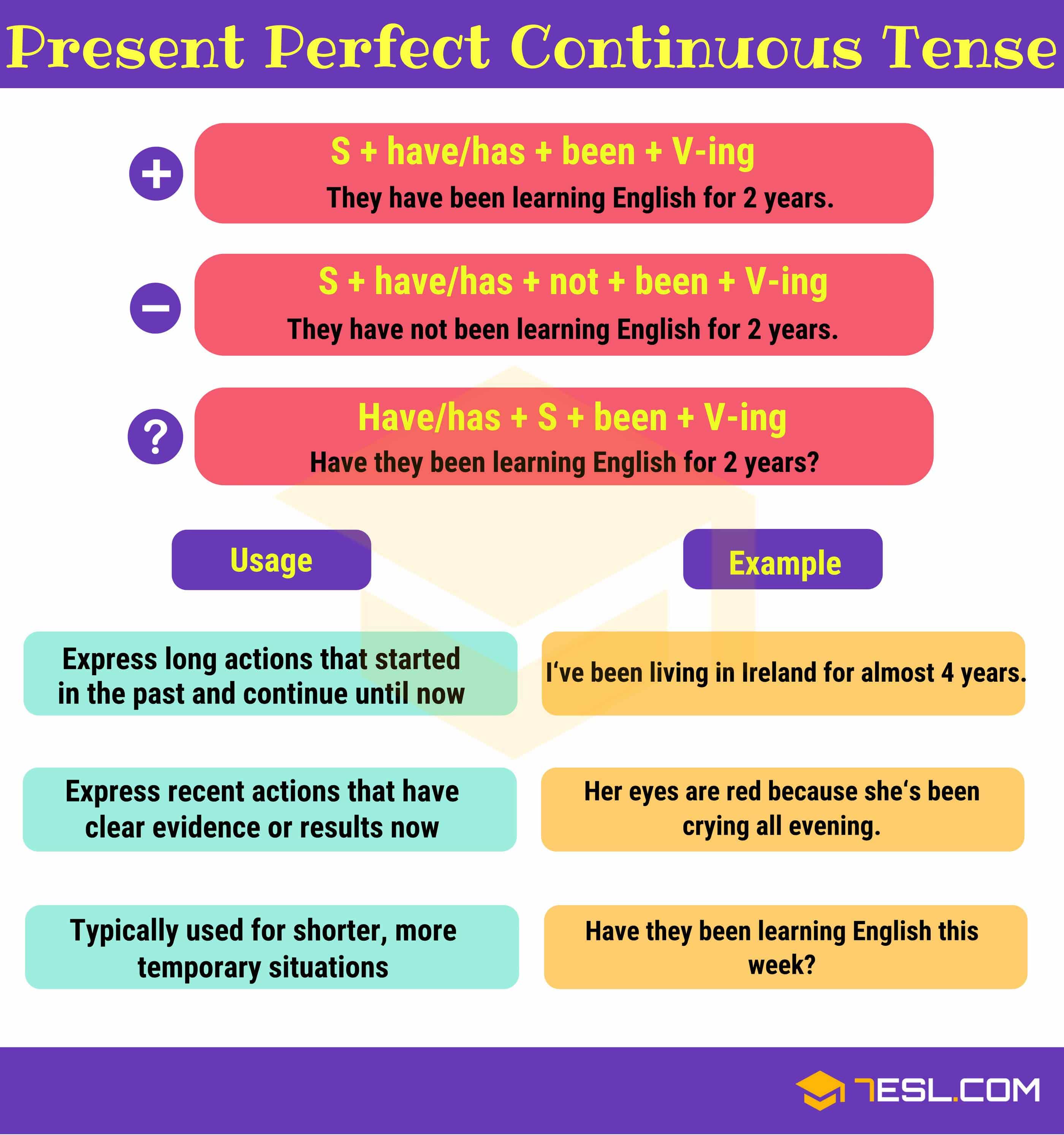Present Perfect Continuous! When we are talking in the present perfect continuous tense (also known as the present perfect progressive tense) we are talking about an action which has begun in the past and is continuing in the present, for example ‘I have been walking down this road all day.’ You might think of this tense as a fusion of the present perfect and the present continuous tenses.
In this section, we are going to be looking at how we must use the present perfect continuous tense and the rules that we must following when using it. This will enable you to create grammatically correct sentences which are easy to understand.
Present Perfect Continuous Tense
What Is the Present Perfect Continuous Tense?
The present perfect continuous verb tense, also known as the present perfect progressive, is used to describe an action that first started in the past and is still happening in the present, or is still relevant to other events happening in the present.
The present perfect continuous tense is typically used for the following two general cases:
- Starting in the past and occurring until now with an adverb modifier that indicates the approximate duration
- An action occurring until lately’ or recently’ with some relevant effect continuing into the present.
This verb tense is formed with a passive variant of the verb to have + the present participle (verb form ending in -ing). These verbs can also take adverb modifiers to talk about the activity when in the past this activity started (e.g. two hours ago’, last Fall’). Additionally, present perfect continuous verb forms are most commonly going to be found in the wild using dynamic verbs’ that describe:
- an activity (e.g. learn, listen, read)
- a process (e.g. change, grow, shrink)
- a bodily sensation (e.g. ache, feel, hurt)
- a transitional event (e.g. arrive, leave)
- a momentary occurrence (e.g. hit, jump, kick).
The other type of verb, which is not generally seen with present perfect continuous verb forms, is known as stative, and the reason it is not used here is that stative verbs describe actions that are done and over with and do not continue into the future at all (e.g. astonish, see, smell).
In the next section are ten examples to demonstrate the various use cases described above. After that are several exercises to provide practice identifying the different forms of the present perfect continuous verb tense. As always, a good way to continually reinforce this information is to try and identify this type of verb while reading and always, always, always keep a dictionary or google search window handy.
Present Perfect Continuous Tense Structure
The structure of the Present Perfect Progressive tense is:
- They have been learning English.
- I have been waiting for one hour.
Present Perfect Progressive Contractions:
The subject and the first auxiliary are often contracted when using the Present Perfect Continuous tense in speaking and in informal writing.
Have = ‘ve
Has = ‘s
Examples:
- I‘ve been writing.
- The car‘s been giving trouble.
Examples of the Present Perfect Continuous Tense
- My daughter has been watching cartoons for the last two hours since arriving home from school.
- The driver has been stopping to stretch his legs every forty-five minutes during this ten-hour drive from Detroit to Washington D.C.
- You have been sleeping too long and missing breakfast.
- My company has been monitoring my Internet usage.
- For the last two weeks, I have been reading The Lord of the Rings books from dawn until dusk.
- I have been picking strawberries from my garden and eating them right away!
- Whenever the dog has been chasing the cat, I can always find tufts of fur on the floor.
- I can always tell when my son has been playing too many video games because his right eye droops with exhaustion.
- My flight has been circling the airport for thirty minutes because the weather is too dangerous for a landing to take place.
- Recently, my daughter has been practicing her dance routine instead of her piano exercises.
How to Use the Present Perfect Progressive Tense?
Learn how and when to use the Present Perfect Continuous tense in English with useful grammar rules and example sentences.
The Present Perfect Progressive tense is used to:
Express long actions that started in the past and continue until now
Examples:
- I‘ve been living in Ireland for almost 4 years.
- I‘ve been studying all day and I’m absolutely exhausted now.
Express recent actions that have clear evidence or results now
Examples:
- You’ve lost a lot of weight. Have you been going to the gym?
- Her eyes are red because she‘s been crying all evening.
Typically used for shorter, more temporary situations
Example:
- Have they been learning English this week?
Note:
Always use the present perfect simple (not continuous) with the verbs believe, know, understand, like/dislike, belong, own:
Examples:
- We‘ve known each other since we were kids.
- I‘ve never understood math very well.
- He‘s always liked sports.







0 Comments